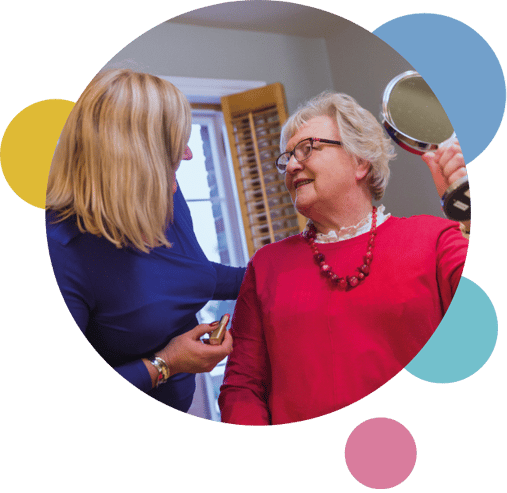How to make stairs safer for the older generation
If you or a loved one have a staircase in your home, it is important to make sure it is as safe as possible. The risk of tripping or falling is a major concern later in life. A study by The Royal Society for the Prevention of Accidents shows that people over the age of 75 are five times more likely to experience a stair-related injury than younger people.
Fortunately, there are some steps that you can take to modify your stairs and make them safer for people with mobility concerns. Here we share five of the best modifications for making stairs safer for the older generation.
Please be advised that these are suggestions only and that it is beneficial to seek the advice of a health and safety professional before making adjustments to your home.

Five safety modifications for stairs
Add handrails
One of the simplest ways to increase the safety of your stairs is to install secure handrails. Many staircases have handrails or bannisters on only one side, but this may not provide enough stability for a person that is unsteady on their feet.
Make sure that the handrails you choose fit your hand comfortably. The bars should be securely attached to the wall at around elbow height. Be sure to test your new handrails before using them to ensure that they can support an adult’s body weight.
There are new types of handrails that fold out horizontally in front of you and move up and down while using your staircase. These can be especially helpful to older people as they allow the person to grip the handlebar with both hands for maximum support.
Remember to always consult a professional occupational therapist or district nurse before purchasing or installing any handrails.
Improve visibility
Dark or poorly lit stairwells are a major fall hazard, especially for people experiencing problems with their eyesight. Ensuring your stairwells are properly lit can help prevent dangerous slips and falls.
You can hire an electrician to install light switches at the bottom and top of your staircases to help with visibility. You can also install LED lights along each individual step or along the wall for extra lighting.
Create non-slip steps
When considering how to make stairs safe for the older generation, pay careful attention to each individual step. Worn-out carpet or wood and laminate flooring can be easy to slip on, especially for people with mobility concerns.
If the carpet on your staircase is worn out or has tears, have a qualified carpet fitter install a new, non-slip carpet. You may also find it helpful to highlight the edge of each step with brightly coloured, non-slip tape to increase visibility. This can be especially useful for the first and last steps where most accidents occur.
It may also help to choose a non-patterned carpet, as those living with dementia can sometimes find it difficult to manage perceptual changes in vision. Using a plain-coloured carpet will make it easier for them to see changes in depth and height.
Remove hazards
As mobility becomes more difficult later in life, it becomes especially important to keep stairs free of clutter. You should avoid using your staircase to store items like laundry baskets, rugs, or shoes. Ideally, the route towards your staircase should also be free of obstacles and well-lit.
Consider installing a stair lift
If ascending and descending your stairs has become especially difficult for you, it might be beneficial to consider installing a stairlift. A stairlift can boost your confidence and reduce the risk of slips and falls in your home. There are a variety of stairlifts to choose from including standing and sitting models. While in the past stairlifts were often bulky and not suited for narrow staircases, there are many new models available that could suit the requirements of your space.
Can I receive help with funding?
If you believe that you could benefit from safety modifications for your stairs, financial help may be available from your local council. In order to qualify, you will have to apply for a needs assessment.
A care needs assessment will be carried out by social services to determine what help and support you need such as care services or special equipment like safety modifications. A needs assessment is free and anyone can ask for one.
If it is determined that you require care, a means test will be undertaken to establish whether you are eligible for funding based on your financial circumstances. This means test will take into consideration any regular income you may receive and any capital assets you own. This includes savings, investments and property.
Contact us today to learn how dedicated live-in care can benefit you and your loved ones.
How live-in care can help
If challenges with ageing, mobility or frailty prevent you from carrying out day-to-day tasks or living your life as independently as you once did, it may be time to consider live-in care. Having the extra care and support from a live-in carer can help you continue to lead the life you are accustomed to in the comfort and familiarity of your own home.
Along with providing respectful and discreet personal care such as support with bathing and toileting, a live-in carer can provide a number of tasks designed to help you maintain your independence and comfort at home. From helping with household duties and medication management to cooking and meal planning, live-in carers provide professional and sensitive care designed to enhance your quality of life.
For over 10 years, The Good Care Group has been providing quality and bespoke live-in care across England and Scotland. We’ll work with you to create a highly-personalised care plan that centres around your individual needs and preferences.
As a general rule, if your capital is assessed at over £23 250 you will not be entitled to local authority funding.
Our live-in carers are trained well beyond the industry standard to provide you with round-the-clock care, support and companionship if, and when, you need it.
On top of assisting you with staircase modifications, our in-house occupational therapist can provide guidance and expert advice on what other home adaptations can improve the safety and mobility around your home. Our holistic and health-driven approach to care is designed to improve health outcomes and well-being for our clients.
Contact us today to learn how dedicated live-in care can benefit you and your loved ones.
Talk to us about your care needs
To talk about your care needs, contact one of our friendly advisors. Calls from landlines are free.

